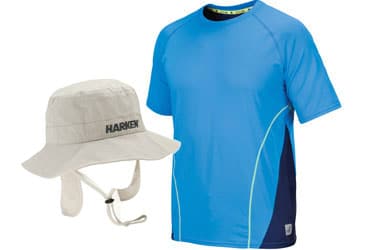
| |Click here to see more UPF clothing. |
Circumnavigator and West Marine outfitting expert Pam Wall likes to ask her seminar audiences this question: What’s the most dangerous thing that we cruisers have to deal with? While many sailors’ thoughts probably go to storms and pirates, the answer she gives them is actually an obvious one, one we deal with daily: the sun.
The cruising life is more or less spent in the sun, especially for those who seasonally follow it. But as we know, our skin pays the price—particularly if you’re fair skinned or burn easily. “In terms of exposure to ultraviolet radiation, sailors face some special challenges,” said Martin Weinstock, M.D., a professor of dermatology at Brown University. “When you’re out on the water, there’s an open horizon, so there’s nothing to block the UV radiation. The water also reflects the sun’s rays, increasing exposure.”
It’s all this extra UV exposure that makes skin protection a constant challenge for cruisers when out on the water. Fortunately, most companies that make specialty sailing, surfing, and outdoor-activity clothing offer clothes specifically designed to protect skin from UV radiation, which is a nice alternative to slathering on the sunscreen or just staying in the shade of the bimini all day. While sun-protective clothing is nothing new, more and more clothing is now labeled as such, and the textile industry has adopted a standard rating system called the ultraviolet protection factor. Similar to the sun protection factor on bottles of sunscreen, the UPF rating is based on how much protection the garment provides. Clothing with a UPF of 15 to 24, which permits roughly 6.7 to 4.2 percent of UV transmission, is rated as “good”; clothing with a rating of UPF 25 to 39, which allows 4.1 to 2.6 percent of UV rays through, is rated as “very good”; clothing with a rating of UPF 40 to 50, which only allows 2.5 percent or less of UV transmission, is rated as “excellent.” Fabric that allows less than 2 percent of UV rays through is simply rated as UPF 50+. By way of comparison, “a plain white T-shirt has a UPF of about 7, and if it gets wet, that falls to about 3,” says Keri Hynes, the clothing specialist at West Marine’s store in Fort Lauderdale, Florida.
There are several features that make some fabrics more UV blocking than others, including the tightness of the weave or knit, the dyes and any chemical treatments used in manufacturing, and the fiber type. In general, a dark, tightly knit polyester shirt offers more protection than a white, loosely woven cotton shirt. Many of the clothing items that will appeal most to sailors are made from high-tech synthetic materials that offer not only UPF 50+ protection but are also quick drying and moisture wicking, so even a long-sleeved shirt can be comfortable on a hot day. Considering that most people don’t apply enough sunscreen to gain the full protection, just throwing on a long-sleeved UPF-rated shirt is a quick and easy way to know that your skin is protected.
Are you headed south this fall? In addition to a wide-brimmed hat and UV-blocking polarized sunglasses, Hynes recommends that cruisers also carry a sun-protective shirt that can be worn in the water and at least one UPF-rated outfit. “I find that lightweight and breathable synthetic materials are the most popular among cruisers. However, these also tend to cost a little more,” she said. “Synthetics are also easier to pack as they don’t wrinkle easily, and they take up less space for travel.”
Pam Wall agrees, “You need a good hat that covers the ears—not a baseball cap! Get a sun-protective hat with a chin strap, and if it has a flap over the back of the neck, that’s even better.”
Jen Brett is a CW associate editor. All photos are courtesy of the manufacturers.
See photos of more clothing that protects you from the sun here.








